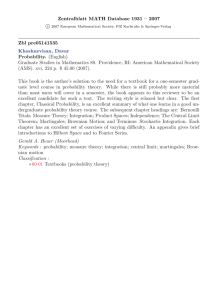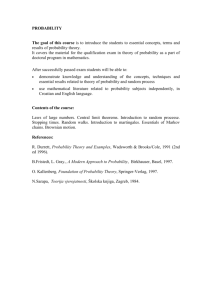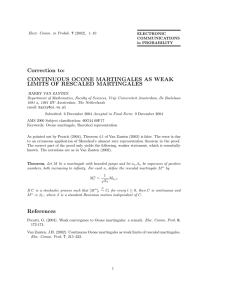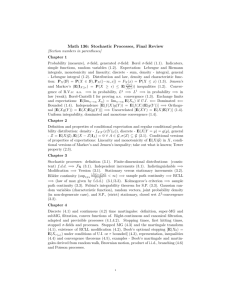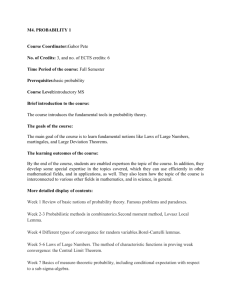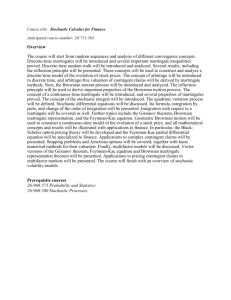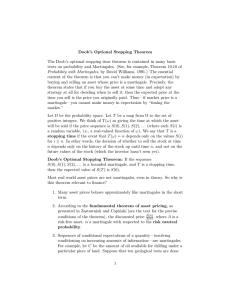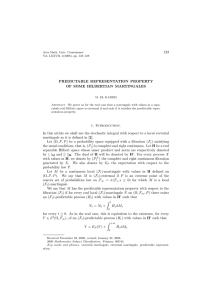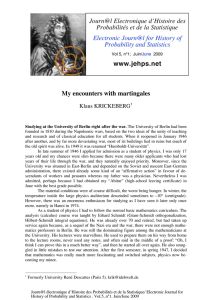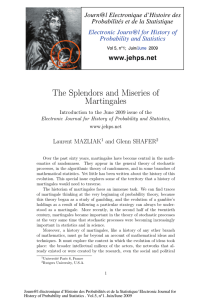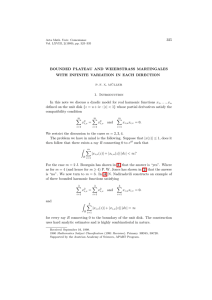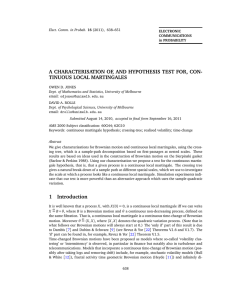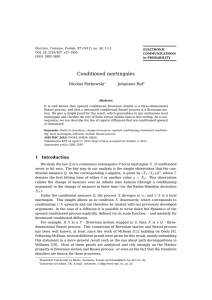WEAK CONVERGENCE TO OCONE MARTINGALES: A RE- MARK
advertisement
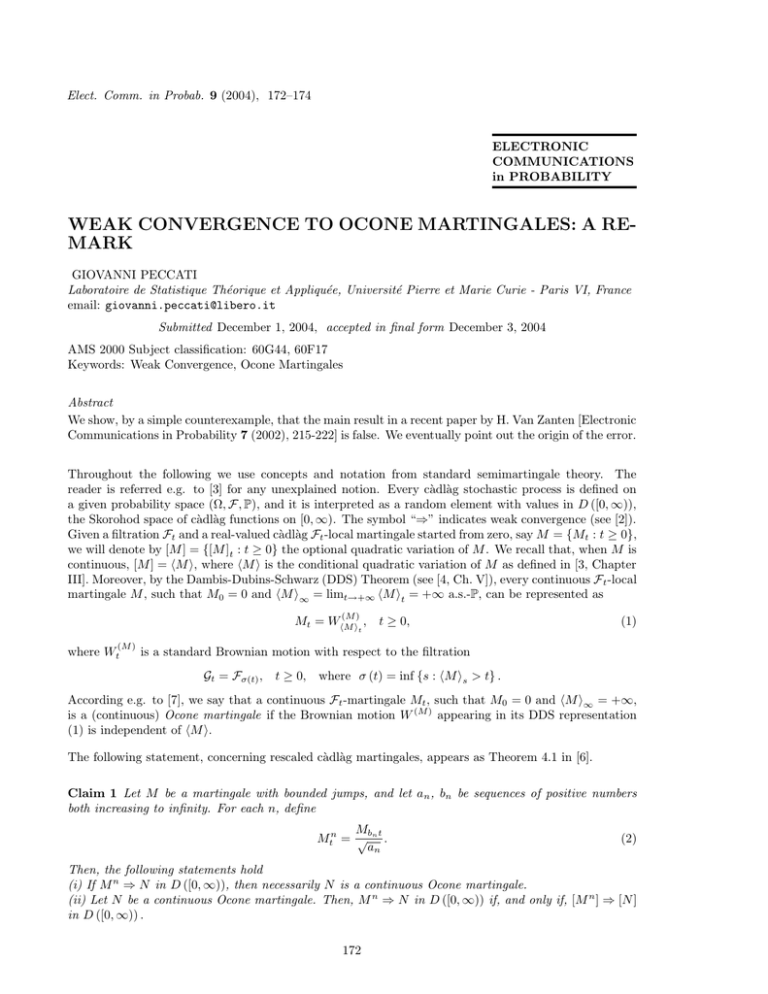
Elect. Comm. in Probab. 9 (2004), 172–174
ELECTRONIC
COMMUNICATIONS
in PROBABILITY
WEAK CONVERGENCE TO OCONE MARTINGALES: A REMARK
GIOVANNI PECCATI
Laboratoire de Statistique Théorique et Appliquée, Université Pierre et Marie Curie - Paris VI, France
email: giovanni.peccati@libero.it
Submitted December 1, 2004, accepted in final form December 3, 2004
AMS 2000 Subject classification: 60G44, 60F17
Keywords: Weak Convergence, Ocone Martingales
Abstract
We show, by a simple counterexample, that the main result in a recent paper by H. Van Zanten [Electronic
Communications in Probability 7 (2002), 215-222] is false. We eventually point out the origin of the error.
Throughout the following we use concepts and notation from standard semimartingale theory. The
reader is referred e.g. to [3] for any unexplained notion. Every càdlàg stochastic process is defined on
a given probability space (Ω, F, P), and it is interpreted as a random element with values in D ([0, ∞)),
the Skorohod space of càdlàg functions on [0, ∞). The symbol “⇒” indicates weak convergence (see [2]).
Given a filtration Ft and a real-valued càdlàg Ft -local martingale started from zero, say M = {Mt : t ≥ 0},
we will denote by [M ] = {[M ]t : t ≥ 0} the optional quadratic variation of M . We recall that, when M is
continuous, [M ] = hM i, where hM i is the conditional quadratic variation of M as defined in [3, Chapter
III]. Moreover, by the Dambis-Dubins-Schwarz (DDS) Theorem (see [4, Ch. V]), every continuous F t -local
martingale M , such that M0 = 0 and hM i∞ = limt→+∞ hM it = +∞ a.s.-P, can be represented as
(M )
Mt = WhM i ,
t
(M )
where Wt
t ≥ 0,
(1)
is a standard Brownian motion with respect to the filtration
Gt = Fσ(t) ,
t ≥ 0,
where σ (t) = inf {s : hM is > t} .
According e.g. to [7], we say that a continuous Ft -martingale Mt , such that M0 = 0 and hM i∞ = +∞,
is a (continuous) Ocone martingale if the Brownian motion W (M ) appearing in its DDS representation
(1) is independent of hM i.
The following statement, concerning rescaled càdlàg martingales, appears as Theorem 4.1 in [6].
Claim 1 Let M be a martingale with bounded jumps, and let an , bn be sequences of positive numbers
both increasing to infinity. For each n, define
Mb t
Mtn = √ n .
an
(2)
Then, the following statements hold
(i) If M n ⇒ N in D ([0, ∞)), then necessarily N is a continuous Ocone martingale.
(ii) Let N be a continuous Ocone martingale. Then, M n ⇒ N in D ([0, ∞)) if, and only if, [M n ] ⇒ [N ]
in D ([0, ∞)) .
172
Ocone martingales
173
Both parts (i) and (ii) of Claim 1 are false, as shown by the following counterexample. Take a standard
Brownian motion started from zero W = {Wt : t ≥ 0}, and define
Mt
=
Mtn
=
Wt2 − t
³ 1
´2
1
Mnt = n− 2 Wnt − t.
n
Then, M is a continuous square-integrable martingale that is not Ocone (since it is non-Gaussian and
−1/2
Mbn t , for an = n2 and bn = n,
pure, see [5, Proposition 2.5] and [7, p. 423]). Moreover, Mtn = (an )
law
and M n = M for each n, due to the scaling properties of Brownian motion. It follows that M n ⇒ M ,
thus contradicting point (i) of Claim 1.
As for point (ii), consider the continuous Ocone martingale (see [7, p. 427])
Nt = 2
Z
t
0
fs
Ws d W
f is a standard Brownian motion independent of W . It is evident that
where W
[N ]t
n
[M ]t
Z
=
4
=
4
n2
t
Ws2 ds
0
Z
nt
Ws2 ds = 4
0
Z t³
n−1/2 Wnu
0
´2
du
law
and therefore that [M n ] = [N ] for each n, although M n converges weakly to the martingale M , which
is not Ocone. This contradicts point (ii) of Claim 1.
The error comes from a misuse of the Skorohod almost sure representation theorem (see e.g. [1, p. 281])
in [6, Section 4]. Starting from p. 219, line 10 of [6], the author considers a sequence
n³
W, τ n
0
´
o
: n0 ≥ 1 ,
0
where W is a standard Brownian motion and τ n is an appropriate time-change, such that
³
W, τ n
0
´
⇒ (B, [N ]) ,
where B is a standard Brownian motion, and [N ] is a positive, continuous and increasing process. Then,
the
allows
one to conclude that, on an auxiliary space, there exist random elements
³ Skorohod
´
´ theorem
³
n0
W , τn
0
and B, [N ] such that
³
W, τ n
0
´
law
=
³
n0
W , τn
0
´
and
law
(B, [N ]) =
³
´
B, [N ] ,
³ n0
´
0
n0
a.s.
where the Brownian motion W depends (in general) on n0 , and W , τ n → (B, [N ]). On the other
hand, the (fallacious) conclusion of Theorem 4.1 in [6] is obtained by supposing that, on the auxiliary
space, there exists a Brownian motion W such that W
due to the counterexamples constructed above.
n0
= W for each n0 , which is clearly not the case,
174
Electronic Communications in Probability
References
[1] Grimmet G. R. and Stirzaker D. R. (1992). Probability and Random Processes. Oxford Science Publications. Oxford.
[2] Jacod J. and Shiryaev A. N. (1987). Limit theorems for stochastic processes. Berlin: Springer-Verlag
[3] Protter P. (1992). Stochastic Integration and Differential Equations. A New Approach. Berlin:
Springer-Verlag
[4] Revuz D. and Yor M. (2001). Continuous martingales and Brownian motion. Berlin: Springer-Verlag
[5] Stroock D. W. and Yor M. (1981). Some remarkable martingales. In Séminaire de probabilités XV,
590-603. Berlin: Springer-Verlag
[6] Van Zanten, J. H. (2002). Continuous Ocone martingales as weak limits of rescaled martingales.
Electronic Communications in Probability, 7, 215-222
[7] Vostrikova, L. and Yor, M. (2000). Some invariance properties of the laws of Ocone martingales. In
Séminaire de probabilités XXXIV, 417-431. Berlin: Springer-Verlag
